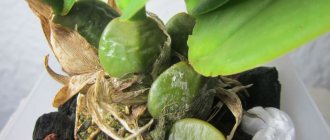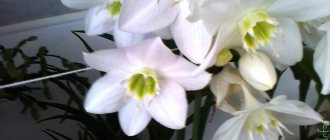Psychopsis is an epiphytic plant belonging to the orchid family. In the past, this variety of orchids was classified as an oncidium species, but at the moment they are positioned as an independent group. Attention to psychopsis is attracted by their delicate flowers, which resemble soaring colorful butterflies over the green stems of the plant. They are often found in Latin America and nearby islands, growing in tropical forests.
In Russia, you can purchase this unusual orchid in large flower hypermarkets or online stores.
You can also buy a seedling from flower growers, but so far psychopsis is rare. [Hide]
Types and varieties
Psychopsis mariposa is native to Central and South America. The orchid grows in tropical forests on tree trunks. The plant has dark green leaves. If the lighting is good, specks and marble stripes may appear on them. Peduncles are tall, thin, strong and straight.
Orchids have a revolving type of flowering, that is, first one bud appears and as it fades, the peduncle throws out another one. The flowers are orange-yellow in color and shaped like moths. Their sizes reach up to 15 centimeters.
Psychopsis papilio - grows in the tropical forests of Ecuador, Venezuela and Peru. Psychopsis moth is an epiphyte reaching a height of 19 to 28 centimeters. Plant pseudobulbs can be oval or round, wrinkled, flattened, and often have speckles or dirty red spots on them. Each bulb produces one leaf, reaching a length of up to 23 centimeters.
The leaves are straight, matte green with veins or reddish spots. The peduncle of the plant reaches from 61 to 152 centimeters in height. Over the course of several months, one flower appears on it, which bloom according to the pattern: one by one. The flowers resemble moths and are flecked with reddish-yellow. The length of the flowers is up to 15 centimeters.
Psychopsis papilio peloric is a plant belonging to the Oncidium family. Orchid flower stalks constantly form buds, so the orchid can bloom for several years. As a result of prolonged flowering, the length of the peduncle can reach a length of 1 meter.
The plant has straight green leaves and reddish-orange flowers interspersed with yellow, reminiscent of exotic butterflies.
Psychopsis kalihi
It is a hybrid of two orchids: psychopsis papilio and kramer. The plant has erect leaves, the length of which is 25 centimeters. Peduncles are rigid, straight, reaching a length of up to 1 meter.
The size of pseudobulbs is up to 4 centimeters. They throw out one sheet at a time. Orchid flowers are yellow-brown in color with burgundy splashes. The flower size reaches from 12 to 15 centimeters.
Psychopsis Kalihi mountain alba - the plant belongs to the Oncidium family. Peduncles reach 1 meter in length. The leaves are green with dark spots. One leaf grows from one pseudobulb. The orchid has a revolving type of flowering (buds appear one after another). The flowers are bright yellow with light yellow marbled stripes.
Psychopsis butterfly - has pseudobulbs that produce two dark green leaves with marbled inclusions. The length of the peduncle reaches 120 centimeters. One bud blooms on it. The flowers are orange in color with brown spots. They are large in size and brightly colored.
Psychopsis mendenhall - the plant has wide, thick, dark green leaves with small marbled splashes of purple. The peduncle can reach one meter and has a revolving type of flowering. The orchid flowers themselves are quite large and have an orange-yellow color.
Psychopsis krameriana
It has flat, oval bulbs that produce a pair of dark green leaves with reddish splashes. Their length ranges from 15 to 20 centimeters. The peduncle reaches a length of 1 meter. A bud blooms on it, turning into a large yellow flower with red-brown splashes.
Psychopsis limminghei - has a compact size. The leaves have a dark green tint with small dark spots. Their length is up to 5 centimeters. The peduncle is up to 10 centimeters long. One bud appears on it, turning into an unusual flower with a yellow-brown color.
Psychopsis versteegiana is native to the tropical forests of Ecuador, Peru and Bolivia. The plant has a long, hard peduncle on which exotic orchid buds appear. The dark green leaves of psychopsis reach a length of 5 to 10 centimeters. The flowers are red and yellow in color with unusual three red petals, similar to the feathers of a tropical bird.
Psychopsis sanderae - has a long, hard peduncle on which two to three buds bloom. The flowers are bright yellow with orange splashes. Psychopsis leaves are dark green with purple splashes.
Kinds
As a result of interspecific crossings, hybrids were obtained: Psychopsis Kalihi , Psychopsis Pavane , Psychopsis Butterfly . These hybrids and their cultivars have also been used in breeding to create Psychopsis Mariposa , Psychopsis Mendenhall , Psychopsis John D. Ramsey and others.
Artificially bred plants are famous for their unpretentiousness and long-lasting (up to 2 years) flowering. True, like natural species, the flowers of these orchids are devoid of fragrance.
Psychopsis moth
Psychopsis papilio
Native to : Trinidad, Venezuela, Colombia, Ecuador and Peru. In Venezuela, this plant is found in the northern provinces of Carabobo, Lara, Merida, Miranda and Trujillo at altitudes of 800–1200 m above sea level.
Psychopsis moth also grows in a relatively high dense forest in Guatopo at an altitude of 460 m. This species is quite widespread, but is not found in the lower, drier parts of coastal forests.
Revolving flowering (produces flower after flower one after another on one peduncle). Flower – 12-13cm.
On the youngest mature pseudobulb, one peduncle 61–152 cm high grows. The peduncles are erect or slightly arched and flattened in the upper part, where single flowers bloom alternately over several months.
Flowering period: can bloom all year, less often blooms in January.
Kramer's Psychopsis
Psychopsis krameriana
Native to: Costa Rica, Panama, Colombia and Ecuador. In Panama, Cramer's Psychopsis is found in the lowlands located along the Chiriqui Lagoon on the Caribbean Sea side, as well as in the vicinity of Puerto Armuelles on the Pacific Ocean side.
The orchid is named after the German gardener Franz Kramer, who managed to get this orchid to bloom for the first time.
From the base of each pseudobulb appear one or two horizontally growing or curved peduncles up to 75 cm long.
Flowers from five to eight. They emerge one by one from the axils of the scales, starting from the top of the peduncle. Each flower lasts about a week.
After the first few flowers have faded, the peduncle lengthens due to one of the nodes located below, and the next flowers appear. In this way, each flower stalk can produce flowers for a year or longer.
Psychopsis Sander
Psychopsis sanderae
Origin : Peru. These plants were found in the department of Junin, but the exact location of their discovery is unknown. Psychopsis Sander grows high on the trunks and large branches of trees in humid mountain forests. The exact height of the habitat of this species is not indicated; it can be approximately estimated as 1220 m above sea level.
The orchid got its name in honor of the German botanist Henry Frederick Conrad Sander, the founder of a nursery in the English city of St. Albans.
A straight or slightly curved peduncle 35 cm long grows at the base of the youngest mature pseudobulb.
There are from two to four flowers on the peduncle, but they bloom alternately. Each next flower appears only after the previous one has faded.
Psychopsis Butterfly
Psychopsis Butterfly
Psychopsis Butterfly is a hybrid of two natural species Psychopsis sanderae and Psychopsis papilio.
This is one of the best orchids for home growing. Its inimitable flowers appear on the peduncle one after another (revolving), for a year or more. Psychopsis Butterfly also has very beautiful marbled leaves.
Psychopsis John D. Ramsey
Psychopsis John D. Ramsey
Psychopsis Mendenhall
Psychopsis Mendenhall
Hybrids
- Psychopsis Kalihis (Psychopsis papilio x Psychopsis kramerianum);
- Psychopsis Peter Micha (Psychopsis kramerianum x Psychopsis ampliatum;
- Psychopsis Kristi Leigh (Psychopsis papilio x Psychopsis stacyi);
- Psychopsis Kulow (Psychopsis papilio x Psychopsis lanceanum);
- Psychopsis Mariposa (Psychopsis papilio x Psychopsis Kalihi);
- Psychopsis Pavane (Psychopsis papilio x Psychopsis versteegianum);
- Psychopsis Rio s Mariposita (Psychopsis papilio x Psychopsis splendidum);
- Psychopsis Widjaya (Psychopsis papilio x Psychopsis Haematochilum).
Psychopsis Kalihi 'Big'
Psychopsis Peter Micha
Psychopsis Mariposa
Psychopsis Mariposa alba
Psychopsis mariposa peloric
Psychopsis Mariposa Tree Lip
Psychopsis Pavane
Psychopsis care at home
Caring for a plant may seem complicated, but in fact it is very simple to grow; the main thing is to follow the rules and the plant will delight you with its delicate flowers and beauty for a long time. Dark green leaves, against which bright exotic flowers stand out, will not leave any gardener indifferent.
Plants are not picky about air humidity. However, you can install a humidifier or simply ventilate the room with the orchid more often. The most comfortable temperature for psychosis is +25 degrees during the day and + 20° at night.
Also, the length of daylight hours is very important for orchids. It must be at least 11 hours. The plant should avoid direct sunlight, and backlighting should be used in autumn and winter.
Cymbidium is also a member of the orchid family. It can be grown with care at home without much hassle if the necessary maintenance rules are followed. You can find all the necessary recommendations in this article.
Photo: Psychopsis Mariposa "Alba"
GENERAL INFORMATION:
In nature, Psychopsis is found in Central and South America, where it grows epiphically on trees at an altitude of 300 to 1000 meters above sea level. Pseudubulbs are unifoliate. The leaves are partly red and marbled. Peduncles are straight, very long (up to 1 meter), appear at the base of the pseudobulbs. The type of flowering is “revolving”, i.e. First one flower appears, as it fades the peduncle lengthens and the next one appears. The flowers resemble butterflies in shape and can reach up to 15 cm in diameter.
TEMPERATURE:
This type of orchid belongs to a moderate-warm temperature regime, and throughout the year it is recommended to grow orchids under the following conditions:
Summer: during the day up to + 25 °C, and at night 18-20 °C. Winter: not lower than + 15 °C.
To successfully grow Psychopsis at home, it is necessary that the night temperature is always 5 °C lower than the daytime temperature. For example, if during the day it is + 25 °C, then at night it should be no more than + 20 °C.
AIR HUMIDITY:
This type of orchid is not demanding of extremely high air humidity; for normal growth and development the plant will need 60-70%. Too dry air negatively affects the development of the plant and its growth is inhibited. To increase air humidity, you can use a humidifier, saucers of water, or wet expanded clay. To do this, take a large tray, inside which expanded clay is poured, a lattice is placed on top to prevent waterlogging of the roots, and pots with orchids are placed. When caring for this type of orchid, the following rule applies: “The higher the thermometer rises, the higher the air humidity should be, and the higher the air humidity, the more often and longer it is necessary to ventilate the room where the orchids are kept, otherwise there is a high probability of rotting and the appearance of leaves of various types of fungal diseases (more details...).”
SUBSTRATE:
This type of orchid is grown both in a substrate and without it, placed on blocks. The substrate must be very breathable, so large pieces of coniferous tree bark (Italian Pinia pine) are best suited for it.
TRANSFER:
It is recommended to replant Psychopsis at least once every 2-3 years, since during this time the substrate manages to lose all its beneficial properties. The best time for replanting is considered to be the period when new shoots reach a size of 5 cm and begin to grow their own roots.
LIGHT:
This type of orchid loves bright sunlight and is able to calmly tolerate direct morning and evening sun, however, on a hot summer afternoon (especially on south-facing windows), the orchid must be protected from exposure to direct sunlight: placed behind a curtain (for example, on a table near the window) or in the shade of other plants, otherwise the plant may get sunburn. In order for the plant to grow well and bloom regularly, the lighting must be not only bright, but also long-lasting. Throughout the year, the duration of daylight should be at least 10 hours. Bright sunlight is the main prerequisite for flowering of this type of orchid. If there is insufficient lighting, the orchid simply will not bloom.
WATERING:
Throughout the year, Psychopsis needs frequent and abundant watering. When watering, excess water should flow freely from the pot, since stagnation of water both inside the pot and in its tray can very quickly lead to rotting of the roots and lower part of the plant. It is recommended to water the orchid using a “hot” shower (water temperature 30-35 °C, maximum 52 °C). This imitates the natural conditions in the orchid’s homeland and has a beneficial effect on the growth and development of the plant. Many years of practice have shown that with regular use of a “hot” shower, orchids not only grow green mass well, but also bloom much more often. The substrate should dry well between waterings.
FEEDING:
Throughout the year, fertilize this type of orchid once every 2-3 weeks at the usual fertilizer concentration indicated on the package. It is necessary to use a specialized fertilizer marked on the package “For orchids”, since ordinary fertilizers for indoor plants contain a slightly different composition of useful substances and their dosage is much higher than Psychopsis needs.
REST PERIOD:
To stimulate flowering, Psychopsis does not need a clearly defined dormant period. However, if you have problems with the flowering of this type of orchid, then during the period when the new young shoots reach the size of the old ones and begin to turn into pseudobulbs themselves, try keeping the plant at a temperature no higher than + 18 ° C and watering somewhat less frequently. If, despite this, the orchid still does not bloom, then the lighting is not enough for it and it needs to be moved to a brighter place or, in addition to natural lighting, use artificial light lamps.
BLOOM:
Representatives of this type of orchid can bloom at any time of the year. The flowering time of each individual flower is 3-4 weeks.
AFTER FLOWERING:
After flowering, the peduncle of Psychopsis is removed only when it begins to dry out, since orchids of this species have a “revolving” type of flowering, when after the flowering of one flower the peduncle lengthens and a new bud appears.
REPRODUCTION:
At home, this type of orchid reproduces only vegetatively, i.e. by dividing a large adult bush into parts. It is recommended to leave at least three pseudobulbs for each new plant. In greenhouse conditions, seed and meristem propagation is also used.
OUTDOOR RESIDENCE:
In the period from mid-May to mid-September, it is possible to find this type of orchid outdoors: on the balcony or in the garden. A place should be chosen that is protected from rain, strong winds and direct sunlight. The ideal place is on the veranda under a canopy.
KNOWN HYBRIDS:
- Psychopsis Kalihis (Psychopsis papilio x Psychopsis kramerianum);
- Psychopsis Peter Micha (Psychopsis kramerianum x Psychopsis ampliatum;
- Psychopsis Kristi Leigh (Psychopsis papilio x Psychopsis stacyi);
- Psychopsis Kulow (Psychopsis papilio x Psychopsis lanceanum);
- Psychopsis Mariposa (Psychopsis papilio x Psychopsis Kalihi);
- Psychopsis Pavane (Psychopsis papilio x Psychopsis versteegianum);
- Psychopsis Rio s Mariposita (Psychopsis papilio x Psychopsis splendidum);
- Psychopsis Widjaya (Psychopsis papilio x Psychopsis Haematochilum).
All materials presented above are the property of this site, the full or partial publication of which (in accordance with the Law on Copyright and Related Rights) on other resources is prohibited.
World of Orchids
Watering psychosis
To prevent the soil from becoming waterlogged and dry out, since this type of orchid does not have a dormant period, psychopsis should be watered all the time. However, to prevent the root of the flower from rotting, you should check the dryness of the soil before the next watering; it must have time to dry out.
Psychopsis should be watered less often in winter, reducing the volume of water. You can moisten the soil using the partial immersion method. When watering an orchid in the usual way, you need to make sure that the liquid does not get on the peduncle or new shoots.
Ofris
Orchid Ophrys (ancient Greek όφρύς - “eyebrow”) is a perennial herbaceous plant from the orchid family , there are more than 150 varieties. Ofris is protected by the Red Book.
Root tubers have a spherical appearance. The leaves are collected in rosettes. Inflorescences are racemes. The flower looks like an insect, the lip is bright and pubescent.
Ophrys insectiferous.
The growing area is quite wide:
- Mediterranean;
- North Africa;
- Asia Minor;
- Southern and Central Europe.
Insectiferous orchid grows up to 35 cm in height. The insectiferous orchid has a spike-shaped inflorescence and an erect flower. Flowers are like insects that have folded their wings. The leaves are red-brown, and the lip is three-lobed with a bluish spot in the middle. The flowering period of ophris is from June to August.
The bee-bearing ophrys grows up to 45 cm. There are from 3 to 8 rare flowers on the peduncle.
The perianth leaves are pink, the green inner petals are short and velvety. The color of the lip is purple-brown with a yellow-brown spot, and there is a yellow border along the edge.
Ophrys bee-bearing plant blooms from May to June. After flowering, a fruit is formed - a capsule.
Decorative orchids are propagated by seeds.
Ophrys bee-bearing.
Important! When keeping a flower at home, keep in mind that opris is self-pollinating and has cross-pollination.
Ofris's homeland in Russia is located on the Black Sea coast of the Caucasus and in the Caucasus. The plant lives in oak and juniper forests and on limestone screes near the mountains. Ophrys is endangered.
Video with a detailed description of the types of Ofris:
Fertilizer for psychosis
There are no breaks in feeding the plants. Many novice gardeners ask: how to feed psychopsis so that it blooms and does not lack nutrients?
For this purpose, specialized fertilizers for psychopsis are used, which have a reduced concentration of nitrogen and urea.
After winter, Psychopsis should be fed with every third watering; in autumn-winter, this should be done less often.
Ground for psychosis
The soil for psychopsis must be moist and breathable. For this reason, you should buy it specifically for orchids; another will not work.
The composition of the soil should include pine bark, moss, expanded clay, charcoal and nut shells. This composition is an ideal option for planting a plant, as it allows you to simulate the growing conditions of psychopsis in the wild.
Landing rules
The soil for all varieties of orchids is made water-permeable and breathable. The substrate must contain large elements:
- sand;
- bark;
- moss;
- stones;
- pebbles.
A third of the height of the pot is occupied by drainage. Experienced gardeners recommend using a transparent pot to better control the condition of the root system. Orchids are replanted no more than once every two years using the transshipment method.
Orchid transplantation step by step.
Psychopsis transplant
In order for the plant to feel comfortable, it should be planted in a pot made of plastic or clay, which must have drainage holes.
Psychopsis transplantation is carried out two to three times a year. The optimal time can be determined by the condition of the plant roots. It is better to wait until the new shoot develops its own root system.
Psychopsis, unlike other orchids, tolerates transplantation easily and recovers quickly. But in order for the plant to feel normal in the new soil, it needs to be properly watered and fertilized from time to time.
Growing and transplanting
Psychopsis reproduces vegetatively. Over time, children appear next to the main pseudobulb. When there are at least six of them in the curtain, division can be made. It is important to completely dry the soil and free the roots from it. Using a sharp blade, cut the stem so that each section contains 2-3 bulbs. This will increase the plant's chances of survival.
The cut site is generously crushed with crushed charcoal and the plant is planted in a new pot. You cannot water the curtain for another 6-8 days, otherwise the cut may rot. Planting is done in small plastic pots with large drainage holes. There is no need to choose transparent containers. Some gardeners plant psychopsis in blocks, and they do not suffer from this at all. The soil for planting must contain the following components:
- pine bark;
- peat;
- sphagnum moss;
- charcoal.
Plants are replanted as the rhizome grows. When replanting, it is important to completely replace the substrate to prevent acidification and rotting of the soil. It is important to ensure that the roots do not grow into the drainage holes. Without moisture they will dry out quickly.
Pruning psychosis
All orchids need pruning from time to time, and psychopsis is no exception. Pruning the plant, or rather its peduncle, is carried out only when it dries out on its own.
While the stem of the peduncle is elastic and green, you cannot touch it, as new buds will appear on it. After it dies, the peduncle can be removed without fear of harming the plant.
Blooming psychosis
All plants of the orchid family bloom simply divinely. Psychopsis is not inferior to them in its exoticism and beauty, the flowering of which occurs from December to February.
However, when psychopsis blooms in the revolver type, its buds can appear all year round. The flowering time of one flower is three to four weeks. Flowers have different shapes and colors, depending on the type and variety of psychopsis.
Leopard orchid
While preparing information on this topic, we were never able to determine exactly what people mean when searching for the Leopard Orchid plant. There are several possible variants of plants that may be implied by this name:
Lily Belamkanda
, the Belamkanda Chinese lily, which is scientifically considered generally an iris (Iris domestica), migrated to our gardens . A perennial with a long flowering period in the garden, it reproduces by self-sowing or dividing the rhizome.
Flower diameter up to 7 cm, flowering period from July to September. The lifespan of an individual flower is 2 hours; when it fades, it curls.
Balakamda sinensis (Iris domestica).
The seed pods form in the fall and resemble blackberries. A young flower can be grown at home and then moved to the garden.
One of the variants of Odontoglossum
Odontoglossums (lat. odontos - “tooth” and glossa - “tongue”) are an epiphytic orchid that emerged from the mountainous regions of Central and South America.
Odontoglossum "Leopard Lily" is shaped like a star. The color of the petals is varied, but the pattern is recognizable, similar to the skin of a leopard. Some varieties have the aroma of lily of the valley or vanilla.
Bicton odontoglossum.
Many species of odontoglossums are used for crossing with other genera (Miltonia, Oncidium) to obtain new hybrids with new colors and scales of flowers. Natural species of Leopard orchids are extremely rare in flower shops.
Orchids in “leopard skins” bloom from October to May on the windowsill at home. The rest period is accompanied by a decrease in temperature to 20 degrees and a decrease in the amount of watering; humidity is kept at least 60%. They are easier to care for compared to other types .
The substrate for transplanting a leopard orchid must necessarily contain bark and peat at a ratio of 3 to 1.
Relatives of leopard orchids are “Tiger orchids”, which belong to the genus Rossioglossum. They are able to bloom from late autumn to late winter.
Psychopsis reproduction
Psychopsis is propagated by bush division. Each new sprout should have three pseudobulbs. When planting divided bushes in pots, old bulbs should be placed closer to the walls so that young shoots have more room to grow.
After dividing and replanting have been done, watering must be suspended for some time.
Diseases and pests
Spider mites are small red parasites that drink plant sap. Leaves affected by mites curl and dry out. You can cope with the pest using a soap solution, which should be sprayed on the plant, or using insecticides such as Aktara.
Scale insects are small pests with a hard brown shell, which is extremely difficult to deal with. They feed on the sap of the plant, gradually destroying it. Their presence is indicated by sticky liquid on the leaves, the appearance of brown spots and drying. You can cope with them with the help of the drug Karbafos.
Mealybugs are small white parasites. They feed on the sap of the plant, which leads to its gradual drying out. Mealybug infestation is indicated by curling flowers and marbled coloring on the leaves. You can overcome the pest using the drugs Karbafos and Aktara
Fungal diseases - excessive watering promotes the appearance of mold and mildew, which leads to rotting of the root system and destruction of the plant. Transplanting the plant into new soil with preliminary treatment of the roots and the use of special antifungal drugs will help cope with this scourge.
Possible difficulties
If after transplanting or dividing the plant's false bulbs shrivel, there is no need to worry. After rooting and resumption of watering, the pseudobulbs are completely restored.
Flowering can be stimulated by a short-term decrease (up to +18°C) in air temperature and a reduction in watering. You will also need to increase the lighting level.
To protect the long peduncle from breakage, it is recommended to install a thin support. By the way, a faded flower shoot should not be removed until it is completely dry. Until then, the likelihood of new flowers appearing is high.
It is very important to monitor the condition of the leaves.
Changes in foliage color indicate excessive/insufficient watering, too bright or too weak lighting. In addition, a dangerous pest, the spider mite, lives on the leaf blades. Editorial team LePlants.ru
The healing properties of psychopsis
Orchids of this type have tonic and rejuvenating properties, so psychopsis petals can be used for cosmetic purposes.
From orchid petals you can prepare a healthy bath for the skin of your hands. For this purpose, you need to take fresh orchid petals, pour boiling water over them and leave for twelve hours.
Soak your hands in the resulting infusion for fifteen minutes, then wash your hands and apply moisturizer to them. This procedure softens the skin and strengthens the nail plate.











